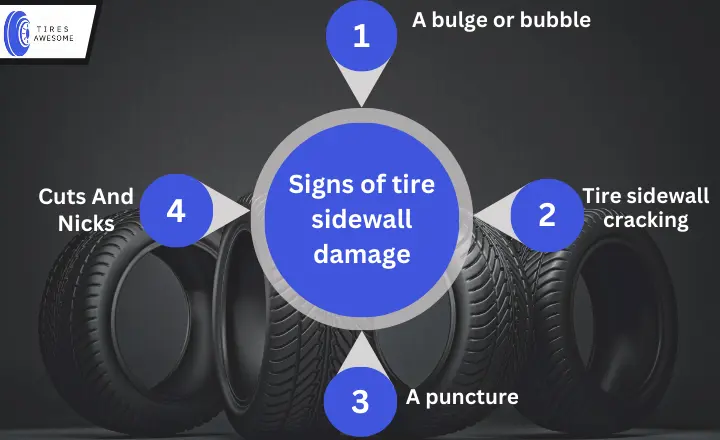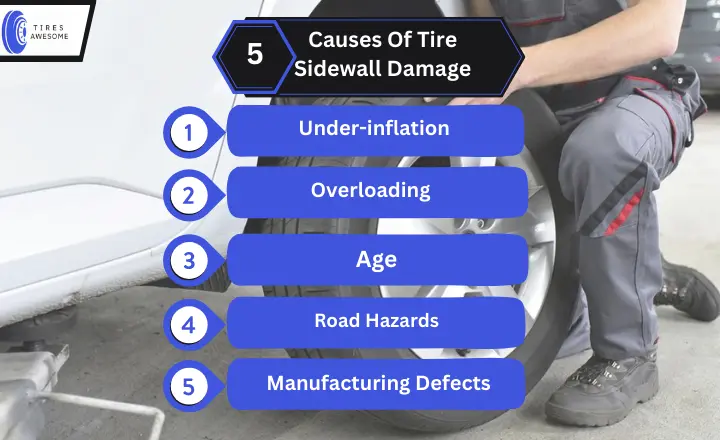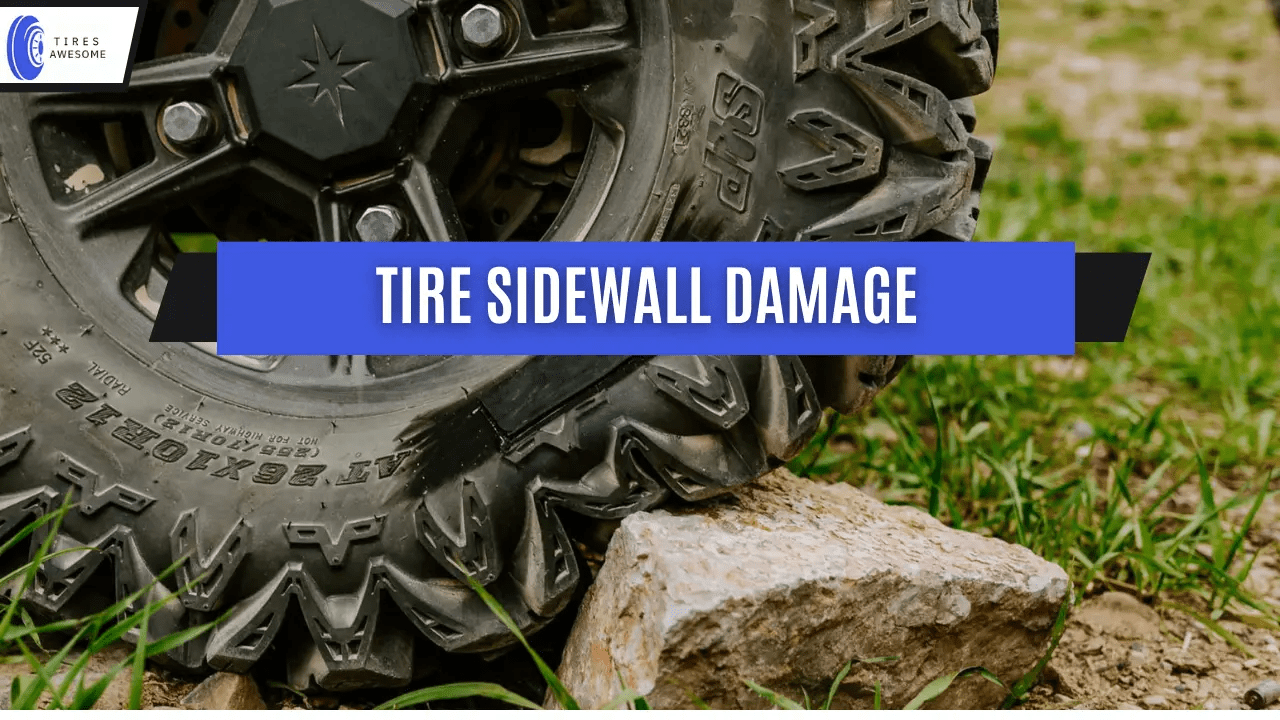I saw some wear on your tires, and I’m unsure if it’s normal or worrying. This guide will explain tire sidewall damage and help you understand its seriousness. It will cover common causes and how to prevent them. This is your primary guide to keeping your tires in good shape.
How To Check Sidewall Damage Tire?
Sidewall damage to tires refers to any harm or injury, including cuts, punctures, bulges, or other visible signs of distress. It’s essential to address such damage promptly. Look for any visible dents, slash tires, or chunks missing from the rubber surface. Inspect the tire for any embedded objects, such as nails or screws, that could have caused puncture wounds.
We have gathered the indicators of sidewall damage to tires below:

- Bulge or bubble on the sidewall: This bulge usually occurs due to internal damage caused by hitting a curb or pothole and can compromise the tire’s structural integrity.
- Sidewall cracking: Another red flag that should be addressed is that these cracks can develop over time due to aging, exposure to harsh weather conditions, or improper tire storage.
- Punctures can result from sharp objects on the road piercing through the tire’s surface.
- Cuts and nicks: Sidewall can weaken the tire, making it more susceptible to failure under stress. Regularly inspecting your tires for these issues will help ensure safer journeys on the road.
What causes sidewall damage tire have?
Despite the durability and stiffness of a tire’s sidewall, various factors can cause damage to it:

Under-inflation
The tire pressure is too low because of temperature changes or tire leak slow air. This low pressure makes the tire’s side bend too much. When a tire isn’t filled enough, it rubs against the road more because the side bends more. This rubbing makes heat, which builds up in the tire. As the tire gets hotter, it weakens and harms the side of the tire.
Overloading
Overloading makes the tires rub more against the road. This extra rubbing creates too much heat, making the tires overheat. When tires get too hot, they can crack and damage the tire’s structure. This damage can make the tire not work right and increase the chance of a tire bursting while driving. This could cause the driver to lose control of the vehicle and cause accidents.
Age
Tires have an expiry date, usually 6 to 10 years after they’re made. Over time, the rubber in tires weakens, especially if exposed to heat and oxygen. As tires age, they become less flexible and can easily get damaged. If you see cracks in your tires, they’re too old and must be replaced immediately.
Road Hazards
Road hazards are dangerous, and drivers must watch for debris, potholes, and curbs. Garbage, like nails or glass pieces, can puncture a tire. Potholes, often found on bad roads or after rain, can cause significant damage if you drive into one fast.
Manufacturing Tire Defects Sidewall
When a tire does not undergo thorough testing before its release, it may have a lower speed rating than necessary. The sidewalls provide stability, support, and protection against road hazards.
They can become overheated and weaken over time. Vandalism also poses a risk to tire sidewall cuts. Intentional slashing or puncturing of tires with sharp objects affects the tread area.
How much sidewall damage is too much for the tire?
We measure the depth of the tire threads to see how bad the damage is. The tire might be seriously damaged if the lines are worn down more than 3 mm or 4.5 mm. The tire’s side is in poor condition because of an air bubble. This bump shows that the tire is damaged inside, which could cause it to burst. A skilled tire professional can check the damage closely and decide if the tire can be fixed or if the tire sidewall is damaged and when to replace it.
Can You Drive On A Tire With Sidewall Damage?
Driving with a damaged tire sidewall isn’t safe or legal because it can risk public safety. Although the tire sidewall seems strong, it’s not as tough as the tread area. Minor tire sidewall damage might not be a big issue if they don’t touch the threads. You can drive safely with slight sidewall damage, depending on the damage and your driving conditions.
Can tire sidewall damage be repaired?
Large punctures and bubbles on the sidewall should not be fixed either. Take immediate action and replace the tire as soon as possible for optimal tire side wall damage safety on the road. Some cuts or punctures may not even require setting when assessing sidewall damage. Repairing it might be unnecessary if the amount is shallow and doesn’t penetrate the sidewall.
How To Prevent Tire Side Wall Damage
To help you avoid this damage, here are some valuable tips:
Drive carefully: It is crucial to drive carefully and be mindful of potential hazards such as curbs, potholes, and debris on the road. These can cause damage to your tires or even lead to accidents.
Recommended air pressure: Keep your tire at the recommended air pressure level; this enhances fuel efficiency and promotes better traction and handling.
Avoid overloading: Avoid overloading your vehicle beyond its tire weight capacity, as this can strain your tires excessively and compromise performance.
Clean your tires regularly: Clean them regularly to remove any dirt or grime accumulation affecting their longevity and grip on the road. Accidents can occur, but we cannot guarantee a zero percent chance of experiencing sidewall damage.
Conclusion
Tire sidewall damage is a big problem that you should pay attention to. Minor sidewall tire damage, scrapes, or cuts might be typical, but more extensive damage, like bulges or deep scratches, can’t be ignored. If you need to figure out how bad the damage is, it’s best to ask a professional. Your tires are essential for your car’s safety, so you should take care of them. Please don’t wait until it’s too late; fix any damage to the side of your tire quickly to stay safe while driving.
FAQs
What to do if there is a tire sidewall tear
?
That tear in tire sidewall is a serious issue and should not be ignored, as it can lead to a dangerous blowout. Tears or cuts in the sidewall cannot be repaired; the only solution is to replace the tire.
What does a Gash in Tire mean?
These include your car pulling to the side or having an off-center steering wheel when moving straight. Check out for any unusual exhaust noises, and inspect your tires for bulges or bends in the rims. A flat tire could also be a result of hitting a pothole.
Why does my car shake at 45 mph?
Tires may become imbalanced due to regular usage, damage, or serious underlying problems. A routine tire rotation and balance should rectify the shaking problem. A sticking brake caliper can also cause shaking at speeds above 45 mph.

